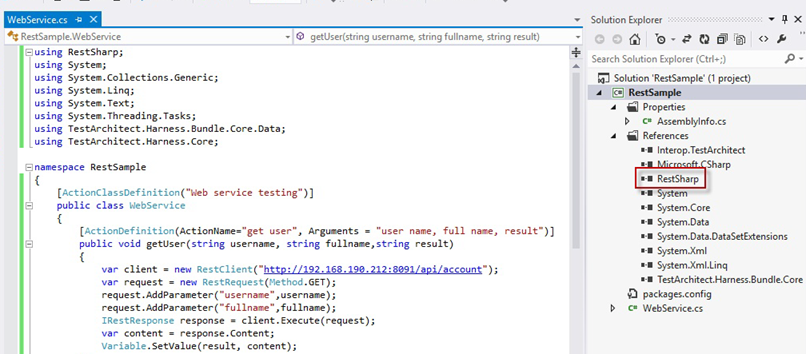Developing your own user-scripted C# bundle harness action
TestArchitect provides sample C# bundle harness code files for you to learn to develop, build, and execute C#-scripted actions.
The following list provides an introductory overview of C# bundle harness folders and files provided with the installation of TestArchitect.
- The diagram below only describes the most important files and folders required to develop C#-scripted programs.
- All of the folders default to <INSTALL_DIR>\harness samples\

- csharp: Root directory of the C# bundle harness sample.
- source: Contains source code of C# user-scripted actions
- executables: Folder containing C# harness executable files and supporting *.DLL file.
bundles: Contains *.DLL files of C# user-scripted actions.
Interop.TestArchitect.dll: a TestArchitect-C# bundle harness library. This library contains interpreter functions necessary when executing C#-scripted actions in TestArchitect.
TestArchitect.Harness.Bundle.Core.dll: Exposes classes and attributes used by the C# bundle harness.
The following custom attributes are provided.
Custom attribute Description ActionClassDefinitionAttribute - Announce that a given class contains user-scripted action’s code implementation ActionDefinitionAttribute - Mark that the method is mapped to a specific user-scripted action
- Define a user-scripted action name and its argumentsAssemblyHarnessBundleAttribute - Specify that this module (assembly) is a C# bundle harness
- Provide bundle information including bundle name, bundle version, etc.
- Defined under the /Properties/AssemblyInfo.csAlso, this DLL exposes additional custom attributes to trigger test run, action, test case, and test module events.
Test case event:
BeginTestCase: Specifies the method to be called before a given test case is executed.
[BeginTestCase] public void BeginTestCase() { //do something }EndTestCase: Specifies the method to be called after a given test case is executed.
[EndTestCase] public void EndTestCase() { //do something }TestCaseContext: Provides data for a given test case event. It is applicable for both BeginTestCase and EndTestCase.
[BeginTestCase] public void BeginTestCase(TestCaseContext context) { //do something } [EndTestCase] public void EndTestCase(TestCaseContext context) { //do something }
Test module event:
BeginTestModule: Specifies the method to be called before a given test module is executed.
[BeginTestModule] public void BeginTestModule() { //do something }EndTestModule: Specifies the method to be called after a given test module is executed.
[EndTestModule] public void EndTestModule() { //do something }TestModuleContext: Provides data for a given test case event. It is applicable for both BeginTestModule and EndTestModule.
[BeginTestModule] public void BeginTestModule(TestModuleContext context) { //do something } [EndTestModule] public void EndTestModule(TestModuleContext context) { //do something }
Action event:
BeginAction: Specifies the method to be called before a given action is executed.
[BeginAction] public void BeginAction() { //do something }EndAction: Specifies the method to be called after a given action is executed.
[EndAction] public void EndAction() { //do something }ActionContext: Provides data for a given test case event. It is applicable for both BeginAction and EndAction.
[BeginAction] public void BeginAction(ActionContext context) { //do something } [EndAction] public void EndAction(ActionContext context) { //do something }
Test run event:
BeginRun: Specifies the method to be called after a given test run is executed.
[BeginRun] public void BeginRun() { //do something }EndRun: Specifies the method to be called after a given test run is executed.
[EndRun] public void EndRun() { //do something }TestRunContext: Provides data for a given test run event. It is applicable for both BeginRun and EndRun.
[BeginRun] public void BeginRun(TestRunContext context) { //do something } [EndRun] public void EndRun(TestRunContext context) { //do something }
TestArchitect.Harness.Executor.exe:
- Loads DLLs of C# bundle harness.
- Controls actions flow, that is, parses harness action and diverts it to the implementation code.
Rules to create a new user-scripted action in a new C# class
Creating a new user-scripted action in a new C# class in the bundle harness involves these steps:
- Create a new C# class to store the function definition for action.
- Add the ActionClassDefinition attribute to inform that this class contains action implementation.
- Create a function definition that provides the actual action-specific logic.
- Add the ActionDefinition attribute to mark the to-be-implemented function to map to a given user-scripted action.
- Define action name and argument names of the user-scripted action by using the ActionName and Arguments attribute properties, respectively.
Rules to add a new user-scripted action to an existing C# class
Add a new user-scripted action to an already existing C# class in the bundle harness involves these steps:
- Create a function definition that provides the actual action-specific logic.
- Add the ActionDefinition attribute to mark the to-be-implemented function to map to a given user-scripted action.
- Define action name and argument names of the user-scripted action by using the ActionName and Arguments attribute properties, respectively.
Important notes to build bundle harness DLLs and deploy dependencies
- Build the solution with the target framework .NET 4.5, and create a release build.
- The DLLs that you build must target the same machine architecture as your installed version of TestArchitect. That is, if you are running the 64-bit version of TestArchitect, build the x64 DLL.
- Once having the DLLs, put them all under the predefined <bundles> folder just one-level deep. In other words, you are not allowed to put the bundle harness DLLs under any subfolders of the <bundles> folder.
- For dependency deployment:
Dependency location:
Under the predefined <bundles> folder, create a subfolder with identical name as the project referenced .
Put the dependency under that folder.
For example: Suppose that you add a reference RestSharp.dll to a project RestSample.


Dependency’s name is not the same as bundle harness DLL’s name.
Avoid conflicted versions of the same dependencies. For example, there are two bundle harnesses including A1 and A2.
- Assign a same dependency but with difference versions to A1 and A2 as follows.
- Assign a dependency, such as B with version 1.0, to A1 bundle harness.
- Assign a dependency, such as B with version 1.1, to A2 bundle harness.
- TestArchitect detects the conflicted versions of the dependency when TestArchitect loads both A1 and A2 bundle harnesses. Consequently, TestArchitect fails to proceed the automation.
- Assign a same dependency but with difference versions to A1 and A2 as follows.
